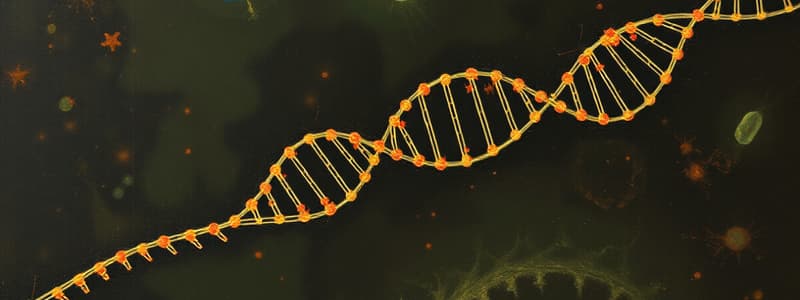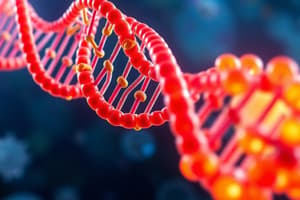Podcast
Questions and Answers
What is the template in semiconservative replication?
What is the template in semiconservative replication?
one strand of the DNA molecule
What is a major difference between eukaryotic DNA replication and prokaryotic DNA replication?
What is a major difference between eukaryotic DNA replication and prokaryotic DNA replication?
- Prokaryotic chromosomes have a single origin of replication, while eukaryotic chromosomes have multiple origins of replication. (correct)
- DNA replication in prokaryotic cells is conservative.
- Prokaryotic replication does not require a primer.
- DNA polymerases of prokaryotes can add nucleotides to both 3' and 5' ends of DNA strands.
A new DNA strand elongates only in the 5' to 3' direction because _____.
A new DNA strand elongates only in the 5' to 3' direction because _____.
- DNA polymerase begins adding nucleotides at the 5' end of the template.
- DNA polymerase can add nucleotides only to the free 3' end. (correct)
- The polarity of the DNA molecule prevents addition of nucleotides at the 3' end.
- Replication must progress toward the replication fork.
What catalyzes the formation of phosphodiester bonds between adjacent nucleotides in the DNA polymer being formed?
What catalyzes the formation of phosphodiester bonds between adjacent nucleotides in the DNA polymer being formed?
Replication in prokaryotes differs from replication in eukaryotes for which of the following reasons?
Replication in prokaryotes differs from replication in eukaryotes for which of the following reasons?
This arrangement permits complementary base pairing?
This arrangement permits complementary base pairing?
Cytosine makes up 42% of the nucleotides in a sample of DNA. Approximately what percentage of the nucleotides in this sample will be thymine?
Cytosine makes up 42% of the nucleotides in a sample of DNA. Approximately what percentage of the nucleotides in this sample will be thymine?
When the rate of DNA repair lags behind the rate of mutation, what is a possible fate of the cell?
When the rate of DNA repair lags behind the rate of mutation, what is a possible fate of the cell?
DNA is synthesized through a process known as _____.
DNA is synthesized through a process known as _____.
Which of the following statements describes a eukaryotic chromosome?
Which of the following statements describes a eukaryotic chromosome?
What is the role of DNA ligase in the elongation of the lagging strand during DNA replication?
What is the role of DNA ligase in the elongation of the lagging strand during DNA replication?
What is meant by the description 'antiparallel' regarding the strands that make up DNA?
What is meant by the description 'antiparallel' regarding the strands that make up DNA?
Which of the following would you expect of a eukaryote lacking telomerase?
Which of the following would you expect of a eukaryote lacking telomerase?
Flashcards are hidden until you start studying
Study Notes
DNA Replication Basics
- Semiconservative replication uses one strand of the DNA molecule as a template for synthesis.
- DNA replication varies between prokaryotes and eukaryotes, primarily in the number of origins of replication: prokaryotes have a single origin, while eukaryotes have multiple origins.
Directionality of DNA Synthesis
- DNA strands elongate only in the 5' to 3' direction because DNA polymerase adds nucleotides to the free 3' end of the growing strand.
Enzymatic Function in Replication
- DNA polymerase catalyzes the formation of phosphodiester bonds between adjacent nucleotides during DNA strand synthesis.
Differences in Replication Mechanisms
- Prokaryotic chromosomes lack histones; eukaryotic chromosomes are associated with histones.
- Prokaryotes produce Okazaki fragments during replication, whereas eukaryotes do not.
Base Pairing Rules
- Adenine pairs with thymine, and cytosine pairs with guanine through hydrogen bonding, allowing for complementary base pairing.
Nucleotide Composition
- In a DNA sample, if cytosine comprises 42% of the nucleotides, then thymine would be approximately 8% due to base-pairing rules.
DNA Damage and Repair
- If DNA repair rates are slower than mutation rates in a healthy cell, the cell may become cancerous.
Eukaryotic Chromosome Structure
- Eukaryotic chromosomes consist of a single linear molecule of double-stranded DNA associated with proteins.
Role of DNA Ligase
- DNA ligase is essential for joining Okazaki fragments on the lagging strand during DNA replication.
Antiparallel Nature of DNA Strands
- The antiparallel nature of DNA refers to the opposite directionality of the two strands, with one strand running 5' to 3' and the other running 3' to 5'.
Implications of Telomerase Absence
- Eukaryotes lacking telomerase are likely to experience a reduction in chromosome length in gametes, which can affect cell division and stability.
Studying That Suits You
Use AI to generate personalized quizzes and flashcards to suit your learning preferences.




